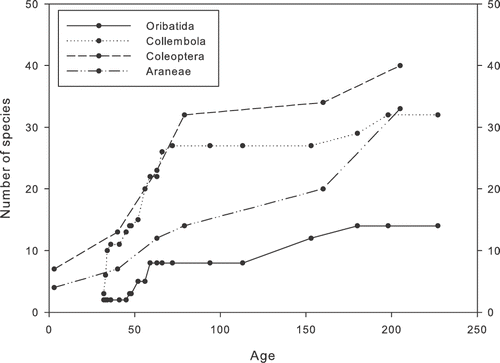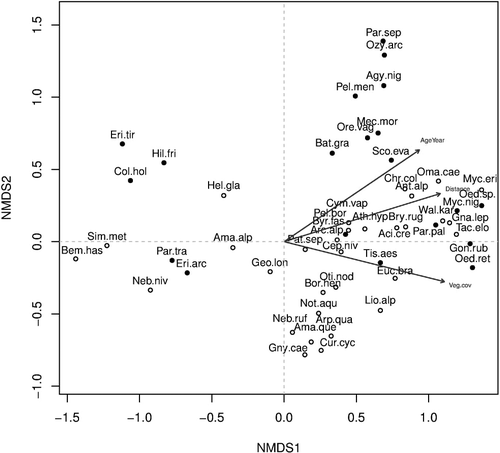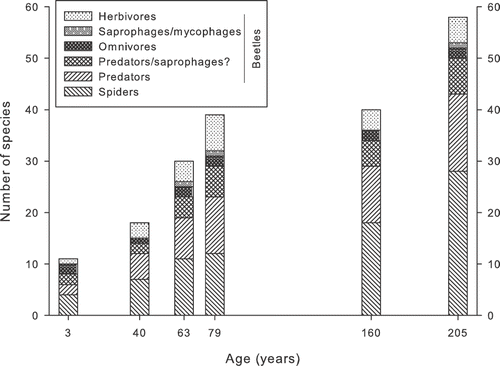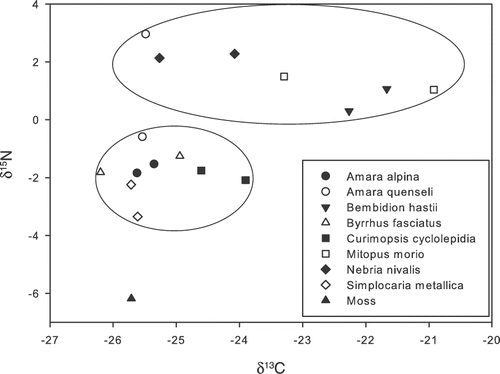Figures & data
Figure 1 Aerial photo showing the position of the six sampling plots close to the receding Midtdalsbreen glacier snout. Moraines from a.d. 1750, 1934, and 2005 are indicated. The location of the study site in south Norway (60°34′N, 7°28′E) is shown on the small map.

Table 1 Significant responses to soil moisture among beetles, described by Spearman rank correlation. The three upper species prefer relatively dry ground, while the three lower species prefer relatively moist ground.
Figure 2 Cumulative species numbers of Oribatida, Collembola, Coleoptera, and Araneae in the Midtdalsbreen glacier foreland. Data for the first two groups are from Salix herbacea vegetation, which is found throughout the foreland.

Table 2 Total catches of spiders per 20 traps at different distance and age. The youngest site was sampled only in 2008, while numbers from the other sites are the sum from 2007 and 2008. For species occurring in at least five samplings, the correlation with the first NMDS-axis is given.
Table 3 Total catches of beetles per 20 traps at different distance and age. The youngest site was sampled only in 2008, while numbers from the other sites are the sum from 2007 and 2008. For species occurring in at least five samplings, the correlation with the first NMDS-axis is given.
Table 4 Correlations between environmental variables and the two first NMDS-axes. Significant correlations are bold-faced.
Figure 3 NMDS-plot showing the position of spiders (filled circles) and beetles (open circles) along the first two axes. Pioneer species are situated at the negative part of the first axis. Full species names are given in –. Environmental vectors are age, distance, and vegetation cover.

Table 5 Correlations between environmental variables. Correlations larger or smaller than |0.325| are significant and bold-faced (CitationZar, 1999).
Figure 4 Distribution of feeding categories among spiders and beetles which were pitfall-trapped at different ages in the Midtdalsbreen foreland. Because spiders are predators, this feeding category dominated throughout the gradient.

Figure 5 δ15N and δ13C values of various pioneer organisms. Except for the moss sample, there were two replicates of each species. The lower circle indicates herbivores, and the upper one predators.

Table 6 Pitfall catches of potential food items for beetles and spiders on a barren, three-year-old moraine. Total numbers in 20 traps are given for 4 two-week periods in 2008.
Table 7 Ecological characteristics of pioneer beetles and spiders living on a barren, three-year-old moraine. Compiled from CitationAndersen (1969), CitationAndersen and Hanssen (1993), CitationBöcher (1988), CitationBrundin (1934), CitationFjellberg (1972), CitationKronestedt (2004), CitationLindroth (1945, Citation1961, Citation1985, Citation1986), CitationMunster (1927–1928), CitationPalm (1948), CitationPalmgren (1976), and Aakra (unpublished).